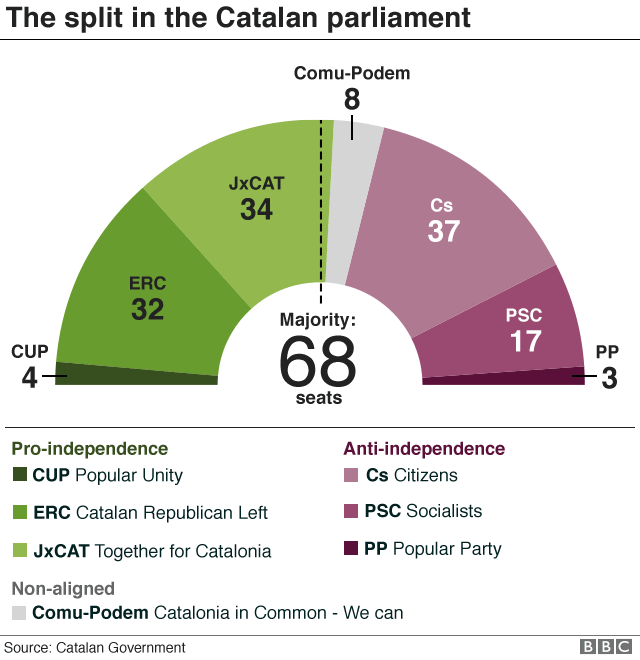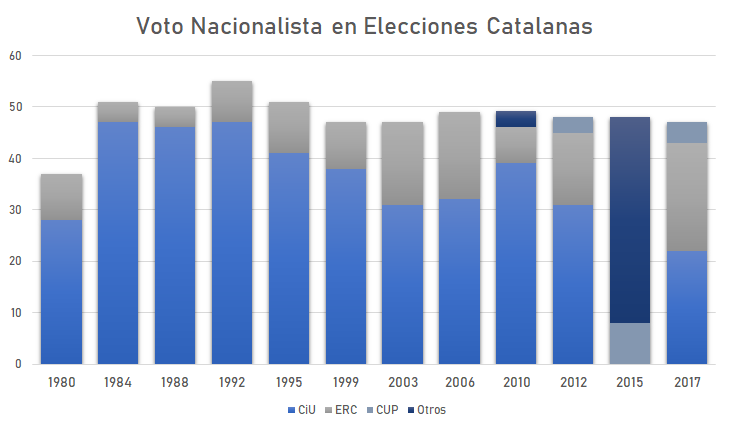The Catalan elections on Thursday produced an expected result in an atypical election. The liberal anti-independence party Ciudadanos won the most representatives but the combined vote share of the pro-independence parties leaves them with a majority of parliamentary seats. Secessionists will probably form a new government and the Catalan conflict will continue in a fashion similar to the developments thus far.
The origins of these crucial elections can be traced back to September when the Catalan government made up of secessionist parties broke Catalan and Spanish law by calling for a referendum on the region’s independence. This unilateral move was criticized by many, even within the pro-independence camp. The Spanish government responded by sending the Guardia Civil, the national police force, into Catalonia on 1 October to prevent the referendum from taking place. This decision resulted in scenes of violence that led to Madrid’s move being heavily criticized by international media and by unionist supporters. A few weeks later, the Catalan government declared independence and then suspended its effects. A further two weeks later, the Catalan president firmly declared unilateral independence again. This generated a judicial process against the Catalan leaders for breaking the law, resulting in the imprisonment of several key figures and the triggering of article 155 of the Spanish constitution. The said article allows the central government to suspend the autonomy of a region temporarily after a violation of the Constitution has taken place. With the powers entailed in this article, the Spanish government took over the Catalan administration and called for new regional elections on 21 December.
Despite the election being held on a working day — the traditional Sunday vote was impossible due to a clash with Christmas Eve — the voter turnout reached a record of 82%, the highest level of participation in any Spanish electoral process. Nonetheless, the results (Figure 1) are of little surprise and show that the conflict will continue in, basically, the exact same terms as has been the case up until now. The huge polarisation of the last months prevented voters critical of their parties’ actions to change their votes because the elections were not primarily about forming a new government nor even about independence. They were about the rejection of article 155 for pro-independence supporters and about the repudiation of breaking the law for unionist supporters. Catalans were deeply divided into pro- and anti- independence supporters and this has not changed in the slightest.

The pro-independence parties (JxCAT, ERC and CUP) won a large minority of the popular vote (47,5%) and a very slight majority of the seats (70 out of 135) due to the fact that the electoral system is biased in their favour. This is basically the same result as in the elections in 2015 and in 2012. In fact, the share of votes cast for nationalist parties has remained the same since 1999 (see Figure 2) and points to the fact that the separatist parties have just enough support to stay in power and press for independence but not enough support to achieve it.

The greatest novelty of the election on Thursday came from the unionist side, where the liberal and anti-independence party Ciudadanos won more seats than any other party (37). This is the first time in history that a non-nationalist party has won an election in Catalonia. However, because the share of seats controlled by the unionist parties does not grant them a majority, it is unlikely that their candidate, Inés Arrimadas, will become president of the Catalan government. The other unionist parties did not do so well. The Socialist party (PSC) received one seat more than in 2015 and the left-wing party CeC-Podemos lost 3 members of Parliament. The great loser was the right-wing Popular Party (PP), which is currently ruling the Spanish government, because it could only hold 3 of its former 11 seats.
Moreover, the formation of the Catalan government is also more complicated now because the leader of the left-wing nationalist party, Oriol Junqueras, is in prison for breaking the law and the leader of the pro-independence right-wing party, Carles Puigdemont, is in Belgium trying to escape the Spanish judicial system. Secessionists are demanding the central government to release their leaders from prison, failing to acknowledge that it is the judges, not the central government, who put them there. Their release would mean a severe violation of the separation of powers and nothing indicates that this will occur before the trials begin. Thus, the possible return of Puigdemont to Spain is the biggest source of conflict in the short term.

In the long run, there are three possible scenarios. In the first one, the parties get together, engage in dialogue and come to a solution (a legal referendum or something of equal importance). This is the scenario that all politicians say they prefer but it is the most unlikely for the simple reason that the conflict provides votes to parties from both sides. As long as their voters hate the other side more than the mistakes of the parties they vote for, dialogue is very improbable and, as Figure 2 shows, there has not been much movement of voters between these blocks since 1999. The second scenario consists of the Catalan government unilaterally declaring independence once again and the Spanish government activating article 155 once more. This scenario is improbable because pro-independence supporters realize that this is a dead end. They did not receive international support from any country and Catalan civil servants and police quickly accepted the takeover by the central government. However, given that the conflict will continue to polarize voters, a new escalation of the situation should not be discarded.
The difficulties to realize scenarios one and two make the third one more probable, where the conflict continues with parties fueling the enthusiasms and hatreds of both sides but, this time, within legality. This is certainly bad news because Catalan and Spanish society is more polarized than ever before, fake news on both sides is preponderant and economic damage produced by the relocation of more than 3000 companies from Catalonia to other parts of Spain resulted in a decrease in growth forecasts of the Spanish economy. Nonetheless, the results of the election point to a continuation of the conflict. Many of us support a solution rooted in dialogue but unfortunately, given the current structure of Catalan society, it seems that the best we can hope for is to keep the conflict confined within some minimal redlines.


